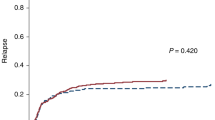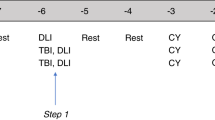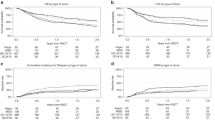Summary:
Over a 3-year period, 145 patients ineligible for myeloablative conditioning underwent reduced-intensity conditioning (RIC) hematopoietic stem cell transplantation (SCT) from an HLA-identical sibling in a prospective study. The median age was 54 years, 88 patients were male and 61 patients were beyond the early-intermediate phase of their disease. The 100-day probability of developing grade II–IV acute graft-versus-host disease (GVHD) was 34%, and the 1-year probability of developing chronic extensive GVHD was 41%. The 1-year probabilities of transplant-related mortality (TRM), overall (OS) and progression-free survival were 20, 60 and 52%, respectively. Multivariate analyses found a better OS in: (i) patients <60 years; and (ii) recipients of a first SCT; and a higher TRM in: (i) age >60 years, (ii) recipients of a prior autologous SCT, and (iii) an ECOG performance status >1. The 1-year TRM in patients with 0 or 1 and >2 of the above-mentioned adverse prognostic factors were 17 vs 53%, respectively (P<0.001). In summary, our study shows that elderly patients have a higher TRM following an RIC protocol. However, age by itself should not preclude these RIC transplants, since TRM appears to be unacceptably high only in the presence of additional adverse factors.
This is a preview of subscription content, access via your institution
Access options
Subscribe to this journal
Receive 12 print issues and online access
$259.00 per year
only $21.58 per issue
Buy this article
- Purchase on Springer Link
- Instant access to full article PDF
Prices may be subject to local taxes which are calculated during checkout



Similar content being viewed by others
References
Giralt S, Estey E, Albitar M . Engraftment of allogeneic hematopoietic progenitor cells with purine analog-containing chemotherapy: harnessing graft-versus-leukemia without myeloablative therapy. Blood 1997; 89: 4531–4536.
Giralt S, Thall PF, Khouri I et al. Melphalan and purine analog-containing preparative regimens: reduced-intensity conditioning for patients with hematologic malignancies undergoing allogeneic progenitor cell transplantation. Blood 2001; 97: 631–637.
Slavin S, Nagler A, Naparstek T et al. Non-myeloablative stem cell transplantation and cell therapy as an alternative to conventional bone marrow transplantation with letal cytoreduction for the treatment of malignant and nonmalignant hematologic diseases. Blood 1998; 91: 756–763.
Carella AM, Champlin R, Slavin S et al. Mini-allografts: ongoing trials in humans. Bone Marrow Transplant 2000; 25: 345–350.
McSweeney PA, Niederwieser D, Shizuru JA et al. Hematopoietic cell transplantation in older patients with marrow transplantation: replacing high-dose cytotoxic therapy with graft-versus-tumor effects. Blood 2001; 97: 3390–3400.
Kottaridis PD, Milligan DW, Chopra R et al. In vivo CAMPATH-1H prevents graft-versus-host disease following nonmyeloablative stem cell transplantation. Blood 2000; 96: 2419–2425.
Martino R, Caballero MD, Canals C et al Allogeneic peripheral blood stem cell transplantation with reduced-intensity conditioning: results of a prospective multicentre study. Br J Haematol 2001; 115: 653–659.
Przepiorka D, Weisdorf D, Martin P et al. 1994 Consense conference on acute GVHD grading. Bone Marrow Transplant 1995; 15: 825–828.
Valcarcel D, Martino R, Caballero D et al. Chimerism analysis following allogeneic peripheral blood stem cell transplantation with reduced-intensity conditioning. Bone Marrow Transplant 2003; 31: 387–392.
Popplewell LL, Forman SJ . Is there an upper age limit for bone marrow transplantation? Bone Marrow Transplant 2002; 29: 277–284.
Blume KG, Forman SJ, Nademanee A . Bone marrow transplantation for hematologic malignancies in patients aged 30 years or older. J Clin Oncol 1986; 4: 1489–1492.
Klingemann H-G, Storb R, Fefer A et al. Bone marrow transplantation in patients aged 45 years and older. Blood 1986; 67: 770–776.
Aschan J, Ringden O . Prognostic factors for long-term survival in leukemia marrow recipients with special emphasis on age and prophylaxis for graft-versus-host disease. Clin Transplant 1994; 8: 258–270.
Deeg HJ, Shulman H, Anderson JE et al. Allogeneic and syngeneic marrow transplantation for myelodysplastic syndrome in patients 55 to 66 years of age. Blood 2000; 95: 1188–1194.
Martino R, Caballero MD, de la Serna J et al. Low transplant-related mortality after second allogeneic peripheral blood stem cell transplant with reduced intensity- conditioning in adult patients who had failed a prior autologous transplant. Bone Marrow Transplant 2002; 30: 63–68.
Branson K, Chopra R, Kottaridis PD et al. Role of nonmyeloablative allogeneic stem-cell transplantation after failure of autologous transplantation in patients with lymphoproliferative malignancies. J Clin Oncol 2002; 20: 4022–4031.
Perez-Simón JA, Kottaridis PD, Martino R et al. Nonmyeolablative transplantation with or without alemtuzumab: comparison with 2 prospective studies in patients with lymphoproliferative disorders. Blood 2002; 100: 3121–3127.
Martino R, Caballero MD, Perez-Simon JA et al. Evidence for a graft-versus-leukemia effect after allogeneic peripheral blood stem cell transplantation with reduced-intensity conditioning in acute myelogenous leukemia and myelodysplastic syndromes. Blood 2002; 100: 2243–2245.
Perez-Simon JA, Martino R, Alegre A et al. Chronic but not acute graft-versus-host disease improves outcome in multiple myeloma patients after non-myeloablative allogeneic transplantation. Br J Haematol 2003; 121: 104–108.
Perez-Simon JA, Diez-Campelo M, Martino R et al. Impact of CD34+ cell dose on the outcome of patients undergoing reduced intensity conditioning allogeneic peripheral blood stem cell transplantation. Blood 2003, (in press).
Mohty M, Bay JO, Faucher C et al. Graft-versus-host disease following allogeneic HLA-identical sibling transplantation with anti-thymocyte globulin based reduced intensity preparative regimen. Blood 2003; 102: 470–476.
Martino R, Caballero MD, Canals C et al. Reduced-intensity conditioning reduces the risk of severe infections after allogeneic peripheral blood stem cell transplantation. Bone Marrow Transplant 2001; 28: 341–347.
Fukuda T, Boeckh M, Carter RA et al. Invasive fungal infections in recipients of allogeneic hematopoietic stem cell transplantation after nonmyeloablative conditioning: risks and outcomes. Blood 2003; 102: 827–833.
Junghanss C, Marr KA, Carter RA et al. Incidence and outcome of bacterial and fungal infections following nonmyeloablative compared with myeloablative allogeneic hematopoietic stem cell transplantation: a matched control study. Biol Blood Marrow Transplant 2002; 8: 512–520.
Chakraverty R, Peggs K, Chopra R et al. Limiting transplantation-related mortality following unrelated donor stem cell transplantation by using a nonmyeloablative conditioning regimen. Blood 2002; 99: 1071–1078.
Niederwieser D, Maris M, Shizuru JA et al. Low-dose total body irradiation (TBI) and fludarabine followed by hematopoietic cell transplantation (HCT) from HLA matched or mismatched unrelated donors postgrafting immunosuppression with cyclosporine and mycophenolate mofetil (MMF) can induce durable complete chimerism and sustained remissions in patients with hematological diseases. Blood 2003; 101: 1620–1629.
Author information
Authors and Affiliations
Corresponding author
Rights and permissions
About this article
Cite this article
Gómez-Núñez, M., Martino, R., Caballero, M. et al. Elderly age and prior autologous transplantation have a deleterious effect on survival following allogeneic peripheral blood stem cell transplantation with reduced-intensity conditioning: results from the Spanish multicenter prospective trial. Bone Marrow Transplant 33, 477–482 (2004). https://doi.org/10.1038/sj.bmt.1704379
Received:
Accepted:
Published:
Issue Date:
DOI: https://doi.org/10.1038/sj.bmt.1704379
Keywords
This article is cited by
-
Patient Selection for Allogeneic Hematopoietic Cell Transplantation (HCT): the Evolution of HCT Risk Assessment
Current Hematologic Malignancy Reports (2015)
-
Survival of hematological patients after discharge from the intensive care unit: a prospective observational study
Critical Care (2013)
-
MTX or mycophenolate mofetil with CsA as GVHD prophylaxis after reduced-intensity conditioning PBSCT from HLA-identical siblings
Bone Marrow Transplantation (2010)
-
Fludarabine phosphate and melphalan: a reduced intensity conditioning regimen suitable for allogeneic transplantation that maintains the graft versus malignancy effect
Bone Marrow Transplantation (2006)
-
Reduced-intensity conditioning for acute myeloid leukemia: is this strategy correct
Leukemia (2006)



